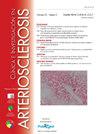确定与内质网应激和线粒体功能障碍有关的新治疗靶点,以降低退行性升主动脉瘤破裂的风险。
IF 1.9
Q3 PERIPHERAL VASCULAR DISEASE
引用次数: 0
摘要
背景:升主动脉瘤(ATAA)是主动脉的一种进行性扩张,80%-90%的患者会因主动脉夹层而死亡。如果伴有衰老和动脉粥样硬化,则预后更差,重建手术是唯一有效的治疗方法。我们的目的是鉴定变性 ATAA 患者中涉及内质网(ER)和线粒体功能障碍的差异表达基因(DEG):方法:利用从退行性ATAA患者(13例)和多器官健康供体(6例)中分离的RNA,通过RNA测序进行转录组分析。利用DESeq2软件包确定了与ER应激和线粒体功能障碍相关的DEGs。使用clusterProfiles软件包进行了丰富通路(Reactome)和蛋白质相互作用(PPI)分析。根据字符串数据库对所选 DEGs 的 PPI 进行分析,并通过 Cytoscape 软件进行可视化:组织学显示,ATAA 患者的主动脉壁细胞外基质(ECM)完全紊乱,细胞丢失,其中 15 个 DEGs 上调,13 个 DEGs 下调,这些 DEGs 编码与 ER 应激相关的蛋白(ATF4、EIF2AK3、HSPA5、ERN1、SEL1L)、线粒体功能障碍(DNML1、IMMT、MT-CO3、MT-CYB、MT ND2、TIMM17B、MT-ERF1、TOMM5)和 ECM 相关蛋白编码的 DEGs 上调 15 个,下调 13 个。GO项和富集通路分析结果表明,这些DEGs主要富集在与主动脉疾病相关的通路中:我们的数据表明,与线粒体功能障碍和ER应激相关的蛋白质可能是治疗ATAA的靶点。本文章由计算机程序翻译,如有差异,请以英文原文为准。
Identificación de nuevas dianas terapéuticas relacionadas con el estrés del retículo endoplasmático y con la disfunción mitocondrial para reducir el riesgo de rotura en el aneurisma de aorta ascendente degenerativo
Background
Ascending Thoracic Aortic Aneurysm (ATAA) is a progressive dilation of the aorta that can be complicated by its dissection leading to death in 80-90% of the patients. When associated with aging and atherosclerosis, the outcome is worse and reconstructive surgery is the only effective therapy. Our objective was to characterize differential expressed genes (DEG) involved in endoplasmic reticulum (ER) and mitochondria dysfunction in patients with degenerative ATAA.
Methods
A transcriptomic analysis was performed by RNA sequencing using RNA isolated from ATAA of patients classified as degenerative (n = 13) and multi-organ healthy donors (n = 6). DEGs related to ER stress and mitochondrial dysfunction were identified with the DESeq2 package. Enriched pathway (Reactome) and protein interaction (PPI) analysis was performed with the clusterProfiles package. PPI of the selected DEGs was analyzed based on the string database and visualized by Cytoscape software.
Results
Histology revealed a complete disorganization of the extracellular matrix (ECM) and cell loss in the aortic wall of ATAA patients where the upregulation of 15 DEGs and the downregulation of 13 DEGs that encode proteins related to ER stress (ATF4, EIF2AK3, HSPA5, ERN1, SEL1L), mitochondrial dysfunction (DNML1, IMMT, MT-CO3, MT-CYB, MT ND2, TIMM17B, MT-ERF1, TOMM5) and ECM was detected. The results of GO term and enriched pathway analysis indicated that these DEGs are mainly enriched in pathways related to aortic diseases.
Conclusions
Our data show that proteins related to mitochondrial dysfunction and ER stress might be therapeutic targets for the treatment of ATAA.
求助全文
通过发布文献求助,成功后即可免费获取论文全文。
去求助
来源期刊

Clinica e Investigacion en Arteriosclerosis
PERIPHERAL VASCULAR DISEASE-
CiteScore
3.20
自引率
6.20%
发文量
44
审稿时长
40 days
期刊介绍:
La publicación idónea para acceder tanto a los últimos originales de investigación como a formación médica continuada sobre la arteriosclerosis y su etiología, epidemiología, fisiopatología, diagnóstico y tratamiento. Además, es la publicación oficial de la Sociedad Española de Arteriosclerosis.
 求助内容:
求助内容: 应助结果提醒方式:
应助结果提醒方式:


